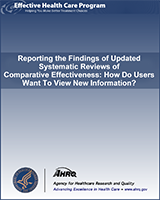NCBI Bookshelf. A service of the National Library of Medicine, National Institutes of Health.
Newberry SJ, Shekelle PG, Vaiana M, et al. Reporting the Findings of Updated Systematic Reviews of Comparative Effectiveness: How Do Users Want To View New Information? [Internet] Rockville (MD): Agency for Healthcare Research and Quality (US); 2013 May.

Reporting the Findings of Updated Systematic Reviews of Comparative Effectiveness: How Do Users Want To View New Information? [Internet]
Show detailsWe conducted this exercise to gather some information on the needs and preferences of users of evidence review updates (and evidence reviews in general) regarding the format in which results are presented. The process we implemented had a number of limitations:
- We included only the executive summaries.
- We used only one EPC report as the basis for constructing our sample versions.
- The particular report we used presented its main results (efficacy and safety) as meta-analyses, which are relatively simple to summarize and compare, whereas many EPC reports do not identify data that lend themselves to meta-analyses.
- We conducted only a small number of focus groups and their sizes were limited, and
- Our selection of participants may have been biased.
However, we did include what we believe is a fair representation of summary formats and potential users and therefore believe a few conclusions may be drawn.
- Although no one really knows who the principal users of evidence reviews and update reviews are, they clearly range from consumers (in some limited circumstances), to community clinicians, to academic clinicians and researchers, to decisionmakers (including guideline- and policymakers, payers, and research planners).
- With the possible exception of consumers, whom we did not query, the entire spectrum of users of update reviews express interest in knowing, explicitly, what has changed. The depth and breadth of information users wish to have regarding the reasons for change depends, at least in part, on the intended use for the information (e.g., not surprisingly, payers, for whom millions of dollars may ride on a change in the most effective treatment for a condition, want the maximum amount of evidence behind any such changes).
- The optimum presentation of evidence review updates may be a combination of a stand-alone executive summary largely consisting of tables and figures, with the updates made extremely salient (e.g., using boldface and parallel construction) and a full report for those who need further information.
We believe that as the Effective Health Care Program continues to update existing evidence reviews, just as we continue to refine our methods for determining the need for an update and for conducting the update reviews, we should continue to seek feedback from topic-specific groups of stakeholders on the most usable formats for presenting the results of these reviews. In particular, additional work needs to be done on the presentation of updated findings as narrative syntheses.
- Conclusions, Limitations, and Discussion - Reporting the Findings of Updated Sys...Conclusions, Limitations, and Discussion - Reporting the Findings of Updated Systematic Reviews of Comparative Effectiveness
Your browsing activity is empty.
Activity recording is turned off.
See more...